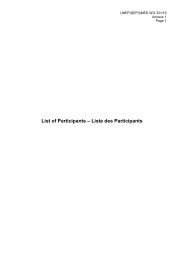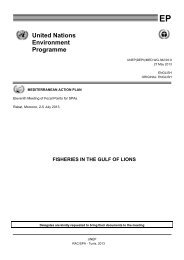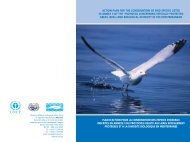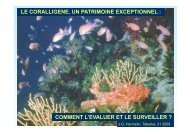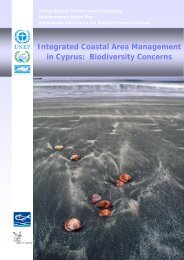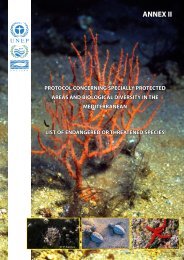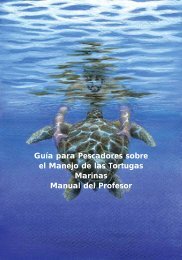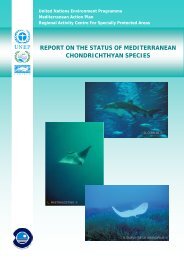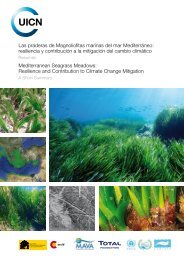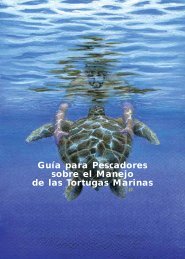Proceedings of the Second Mediterranean Symposium on Marine
Proceedings of the Second Mediterranean Symposium on Marine
Proceedings of the Second Mediterranean Symposium on Marine
You also want an ePaper? Increase the reach of your titles
YUMPU automatically turns print PDFs into web optimized ePapers that Google loves.
PROCEEDINGS OF THE SECOND MEDITERRANEAN SYMPOSIUM ON MARINE VEGETATION (ATHENS, 12-13 DECEMBER 2003)<br />
238<br />
SEAGRASS ECOSYSTEMS AS BIOLOGICAL INDICATORS.<br />
A COMPARISON OF TWO APPROACHES: LEAF EPIPHYTE TAXONOMY<br />
AND A COMBINED SET OF BIOLOGICAL DESCRIPTORS<br />
Begoña MARTINEZ, Adriana VERGÉS TRAMULLAS, Patricia PRADO, Javier ROMERO and<br />
Teresa ALCOVERRO.<br />
ABSTRACT<br />
The main objective <str<strong>on</strong>g>of</str<strong>on</strong>g> <str<strong>on</strong>g>the</str<strong>on</strong>g> present study is <str<strong>on</strong>g>the</str<strong>on</strong>g> comparis<strong>on</strong> <str<strong>on</strong>g>of</str<strong>on</strong>g> two separate approaches<br />
to <str<strong>on</strong>g>the</str<strong>on</strong>g> use <str<strong>on</strong>g>of</str<strong>on</strong>g> P. oceanica meadows as biological indicators <str<strong>on</strong>g>of</str<strong>on</strong>g> water quality. One is based<br />
<strong>on</strong> <str<strong>on</strong>g>the</str<strong>on</strong>g> use <str<strong>on</strong>g>of</str<strong>on</strong>g> a combined set <str<strong>on</strong>g>of</str<strong>on</strong>g> biological descriptors (physiological, morphological,<br />
structural, communal and envir<strong>on</strong>mental) and <str<strong>on</strong>g>the</str<strong>on</strong>g> o<str<strong>on</strong>g>the</str<strong>on</strong>g>r is based <strong>on</strong> <str<strong>on</strong>g>the</str<strong>on</strong>g> tax<strong>on</strong>omy <str<strong>on</strong>g>of</str<strong>on</strong>g> leaf<br />
epiphytes. Both sets <str<strong>on</strong>g>of</str<strong>on</strong>g> descriptors were measured in 12 locati<strong>on</strong>s, eight <str<strong>on</strong>g>of</str<strong>on</strong>g> which were<br />
deep (15 m) and four <str<strong>on</strong>g>of</str<strong>on</strong>g> which were shallow (5 m). The selecti<strong>on</strong> <str<strong>on</strong>g>of</str<strong>on</strong>g> <str<strong>on</strong>g>the</str<strong>on</strong>g>se locati<strong>on</strong>s was<br />
based <strong>on</strong> a previous four-year seagrass m<strong>on</strong>itoring study and was aimed at <str<strong>on</strong>g>the</str<strong>on</strong>g><br />
homogenous cover <str<strong>on</strong>g>of</str<strong>on</strong>g> a wide range <str<strong>on</strong>g>of</str<strong>on</strong>g> water qualities, from poor to quasi-pristine<br />
c<strong>on</strong>diti<strong>on</strong>s. Principal comp<strong>on</strong>ent analysis (PCA) applied to a set <str<strong>on</strong>g>of</str<strong>on</strong>g> biological descriptors<br />
resulted in two principal comp<strong>on</strong>ents which explained 46% <str<strong>on</strong>g>of</str<strong>on</strong>g> <str<strong>on</strong>g>the</str<strong>on</strong>g> variance. Comp<strong>on</strong>ent<br />
I appears to be related to c<strong>on</strong>diti<strong>on</strong>s <str<strong>on</strong>g>of</str<strong>on</strong>g> eutrophia and metallic c<strong>on</strong>taminati<strong>on</strong> and<br />
explains 28.8% <str<strong>on</strong>g>of</str<strong>on</strong>g> variance. Comp<strong>on</strong>ent II explains 17.2% <str<strong>on</strong>g>of</str<strong>on</strong>g> variance and seems to be<br />
related to herbivory, which is c<strong>on</strong>siderably more intense in shallow locati<strong>on</strong>s.<br />
Corresp<strong>on</strong>dance analysis applied to leaf epiphyte tax<strong>on</strong>omy <str<strong>on</strong>g>of</str<strong>on</strong>g> axis I and II explain 22%<br />
and 17.1% <str<strong>on</strong>g>of</str<strong>on</strong>g> <str<strong>on</strong>g>the</str<strong>on</strong>g> variance respectively. Axis I provide an ordering <str<strong>on</strong>g>of</str<strong>on</strong>g> locati<strong>on</strong>s that is<br />
related to existing water quality data, whilst axis II again seems to be related to herbivory.<br />
The two approaches are coherent with <strong>on</strong>e ano<str<strong>on</strong>g>the</str<strong>on</strong>g>r, and <str<strong>on</strong>g>the</str<strong>on</strong>g>y both provide a good<br />
indicati<strong>on</strong> <str<strong>on</strong>g>of</str<strong>on</strong>g> water quality. The ordering <str<strong>on</strong>g>of</str<strong>on</strong>g> locati<strong>on</strong>s provided by both sets <str<strong>on</strong>g>of</str<strong>on</strong>g> descriptors<br />
is coherent with existing water quality data from <str<strong>on</strong>g>the</str<strong>on</strong>g> regi<strong>on</strong>. Even though <str<strong>on</strong>g>the</str<strong>on</strong>g> two<br />
approaches provide remarkably similar results, <str<strong>on</strong>g>the</str<strong>on</strong>g> combined set <str<strong>on</strong>g>of</str<strong>on</strong>g> biological indicators<br />
<str<strong>on</strong>g>of</str<strong>on</strong>g> <str<strong>on</strong>g>the</str<strong>on</strong>g> Posid<strong>on</strong>ia oceanica ecosystem appears as a more powerful tool in <str<strong>on</strong>g>the</str<strong>on</strong>g><br />
discriminati<strong>on</strong> <str<strong>on</strong>g>of</str<strong>on</strong>g> medium-to-good water qualities. Meadows found in shallow waters are<br />
clearly influenced by internal forcings such as herbivory, which are in no apparent way<br />
related to water quality. For that reas<strong>on</strong>, deeper meadows are recommended for use in<br />
any future m<strong>on</strong>itoring studies.



